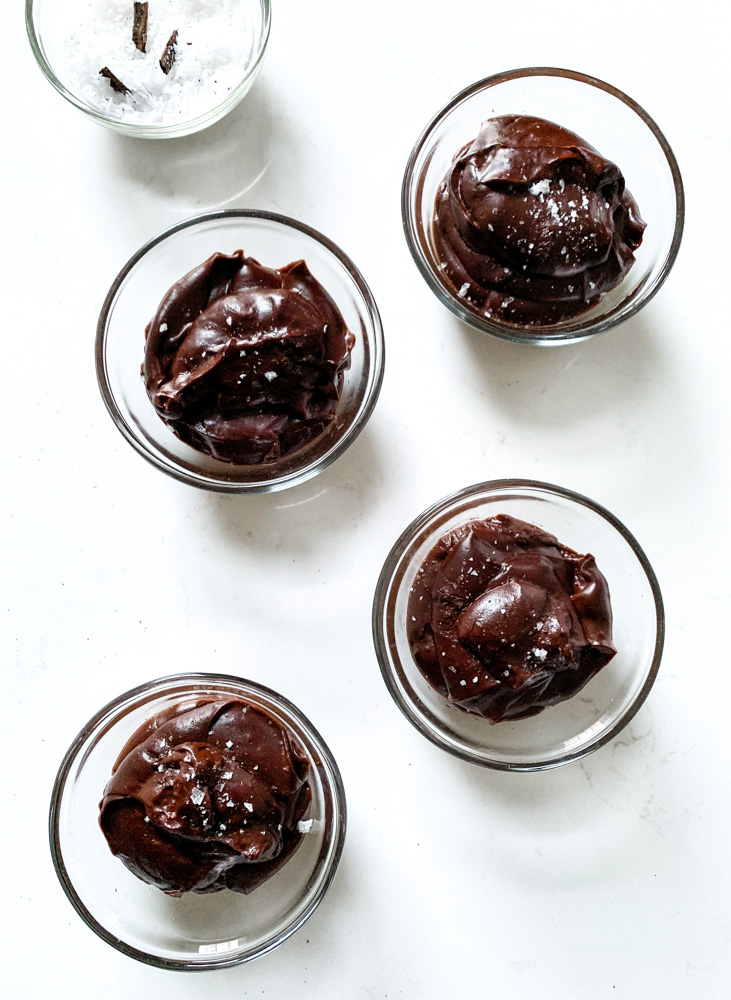
A photographer I once worked with told me that his first kiss was behind the Maldon Sea Salt factory in Essex, England. Maldon sea salt is worthy of such a memory; it’s also a food stylist’s dream. Each crystal is textured with just the right amount of shape, shine and crunch. Imagine the crystals scrunched between the index finger and thumb, falling over an oozing soft-poached egg. Or scattered across a tangle of sticky, maple-syrup glazed roasted carrots. The camera grabs these little shapes, each as unique as a snowflake.
I sprinkled sea salt mixed with vanilla over dark chocolate and coconut puddings. Of course I thought about first kisses, as I always do when sea salt is involved. I rolled my eyes a little and giggled… English seaside mud flats and windswept Dickensian buildings where the Maldon Factory sits beats the closet I was wedged into for my first kiss. My eye roll shifted to a satisfied smile as I inhaled the vanilla. I know this combination is going to be an aromatic, textural explosion.
These culinary, sensory experiences always pull me out of myself. I’ve been away from work and creativity for weeks now. I had started to feel like Marty McFly in Back To The Future, when he fades from his family photo as his time-travel plans begin to slip away.
But then I started to engage, just a little. I scraped one pod’s worth of vanilla seeds and mixed them into a half cup of flaky sea salt. I let it sit for a while in a jar so the flavours could mingle, then I began sprinkling with wild abandon- on warm chocolate chip cookies. Brownies. And now, chocolate pudding.
Initially I thought the fade away feeling came from a lack of engagement in social media. Minimal creative presence equals minimal communication, and therefore no connection. Does no connection mean one is dry? Irrelevant? Invisible?
But then my aunt Sandra read a passage out loud at a dinner party. We – four friends – were gathered around her table, sharing our lives, our work, our struggles, all over luscious caramelized leeks with goat cheese, Ottolenghi frittatas, a deep red, roasted beet salad, squash soup topped with shards of fried ginger, and finally, chocolate coconut puddings finished with vanilla sea salt. She read The New York Times T magazine editor’s letter (see below), encouraging us as artists to just show up for work, because it’s the repetition, the devotion, that counts.
“This is why this magazine tends to focus on mid career and late career artists of all disciplines,” writes Hanya Yanagihara, the magazine’s editor. “People who have been plying their lonely crafts for years, sometimes when it seemed that no one was paying attention.”
When no one is paying attention. When there are no likes. No comments. Because it’s the work that makes me feel good, the connection to craft, the showing up each day, regardless of how long. It’s not the likes that count; they’re fleeting, like a kiss in a closet. It’s a sprinkle of salt, a touch of vanilla and a table full of friends who work, even when no one is paying attention, that makes me feel full again.
Hanya Yanagihara is the editor in chief of T magazine. This is her letter from T Magazine’s Men’s Fashion Issue:
Everyone loves the new: new things, new sensations, new talents. Our industry, and many others, are in fact built on the pursuit of discovery, the thrill of anointment, the excitement of prediction.
But what is new is not necessarily what is true. Or rather: What is new is sometimes mostly interesting because of its promise, because we can project onto it our own frustrated ambitions. If you are a young, new artist, such attention can be gratifying, of course — and is increasingly important in order to launch a career — but it can also be damaging; once the spotlight pivots from you to someone even younger and newer, what remains?
The answer, as always, is work: decades of it, if you’re lucky. It’s in these decades that a talent matures into an artist … or not. Those 20 or 30 or 40 or 50 years are, more than a debut show, book or exhibition, the only thing that separates an artist from, say, a gifted painter, or a playwright from a good writer. These are the decades in which you prove yourself to yourself. No longer are you the great new hope. The world may care (sometimes deeply) about what you produce; it may not care at all. But what the world thinks matters less (or it should), because the work itself has come to mean more.
This is why this magazine tends to focus on midcareer and late career artists of all disciplines, people who have been plying their lonely crafts for years, sometimes when it seemed that no one was paying attention. Sometimes the artist’s acquaintance with obscurity is long behind him, as in the case of Jasper Johns, who has, as M.H. Miller writes in his profile, managed to consistently define and speak to America for the past 60 years. But even Johns, now 88, still gets up every day and goes to his studio. In this, one of the greatest artists in modern history shares something elemental with the most unknown or the youngest — the work must be done, and it only gets done if you do it.
In my life outside T Magazine, I am a writer, and when I leave the office at night, I return to my desk at home to (try to) write. It doesn’t always happen. Part of my fascination with the midcareer artist is that, as a midcareer, middle-aged artist myself, I’m always looking to other people’s lives for clues about how to be. Occasionally, people ask me for advice, and the only, and best, encouragement I can give them is that you will never be an artist if you don’t finish your work. It sounds so simple, and so obvious, and it is. But it’s also true: You will never become an artist if you don’t spend every day being an artist.
Talent is sexy. Work is not. Only one, however, is actually essential. Your career begins if you have the former. But it’s finished if you don’t do the latter.
